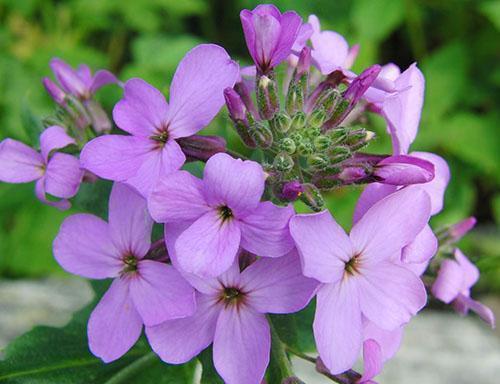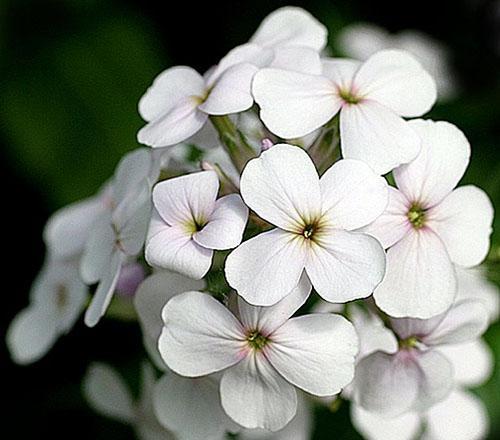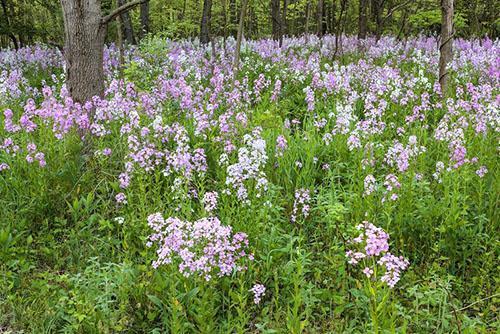Amazing cruciferous flower night violet
 Choosing ornamental plants for their garden that can give the site a unique and memorable look, summer residents often pay attention to the lush blooming species. Therefore, in the light of day, flower beds and front gardens delight with bright colors and aromas, and with the onset of dusk, the corollas close, the smells dissipate. But at night such a garden loses its charm and former charm. This is because insects are pollinators for most flowering crops. It is to attract them that flowers tear off variegated corollas and spread their fragrance.
Choosing ornamental plants for their garden that can give the site a unique and memorable look, summer residents often pay attention to the lush blooming species. Therefore, in the light of day, flower beds and front gardens delight with bright colors and aromas, and with the onset of dusk, the corollas close, the smells dissipate. But at night such a garden loses its charm and former charm. This is because insects are pollinators for most flowering crops. It is to attract them that flowers tear off variegated corollas and spread their fragrance.
And yet there are plants that, when planted in the garden, you can enjoy the intoxicating aromas all night long. One of them is the night violet flower, familiar to many gardeners. Under this popular name, two related crops belonging to the cruciferous family are grown in flower beds.
These are hesperis and mattiola, opening their corollas in full force in the evening and spreading a very pleasant smell throughout the night. Plants, which are very similar in type and structure of flowers, have a very unpretentious disposition and a long history of growing in the gardens of Europe and our country.
None of the other plants are biologically related species in relation to viola, uzambara and horned violetsgrown as indoor and garden crops. Violet flowers are called due to the range and shape of corollas that once fell into the culture of cruciferous plants.
Hesperis - night violet for a beautiful garden

In Russia, hesperis is known among gardeners under the name nocturnal or night violet and, as in the photo, the varieties of this culture can reveal flowers of white and lilac shades.
The species that came from Europe gained popularity in our country two centuries ago, and in France and the Mediterranean countries, hesperis became famous as an ornamental and medicinal plant in the Middle Ages.
Group planting of a plant is especially beautiful, while growing violets does not require special skills and even beginners in floriculture can do it. Unfortunately, recently summer residents have lost interest in this culture, which once created a unique atmosphere in the landscape parks of Russian estates and country estates up to the beginning of the 20th century.
 Called nocturnal, nocturnal violet or hesperis flower unites about 30 related subspecies, some of which have found a place on flower beds and in parks. Some representatives of the species grow in Asia Minor and the Caucasus. Moreover, under favorable conditions, hesperis is a perennial herb, found in the wild almost everywhere, from roadsides to forest edges and banks of water bodies.
Called nocturnal, nocturnal violet or hesperis flower unites about 30 related subspecies, some of which have found a place on flower beds and in parks. Some representatives of the species grow in Asia Minor and the Caucasus. Moreover, under favorable conditions, hesperis is a perennial herb, found in the wild almost everywhere, from roadsides to forest edges and banks of water bodies.
In culture, the night violet is grown as a biennial, which makes it possible to achieve the most lush and even flowering of plants.
 Covered with simple lanceolate leaves, the stems of hesperis reach a height of 90 cm.The foliage is covered with small sparse hairs; it is attached to the shoots on short strong petioles. The lower to the ground, the larger the size of the leaf plates, while the largest leaves can exceed 12 cm in length and 4 cm in width.
Covered with simple lanceolate leaves, the stems of hesperis reach a height of 90 cm.The foliage is covered with small sparse hairs; it is attached to the shoots on short strong petioles. The lower to the ground, the larger the size of the leaf plates, while the largest leaves can exceed 12 cm in length and 4 cm in width.
The inflorescences are quite dense, in the form of a brush or a cap. Flowers of all varieties of violets, as in the photo, open from the periphery to the center. In some cases, the length of the brush reaches 20-30 cm. The flowers themselves are small, symmetrical. Corolla diameter from 1 to 2 cm.
 The first buds open in May, and then hesperis blooms almost without interruption until mid-July. In place of flowers, narrow, oblong pods appear, in which small brown or brown seeds ripen. If you do not cut the peduncles, the ripening seeds spill out and are capable of giving young shoots the next year.
The first buds open in May, and then hesperis blooms almost without interruption until mid-July. In place of flowers, narrow, oblong pods appear, in which small brown or brown seeds ripen. If you do not cut the peduncles, the ripening seeds spill out and are capable of giving young shoots the next year.
Despite the opening of the corolla at night and the fragrance of the flowers of the night violet, it is a light-loving plant. But the direct rays of the sun are harmful to hesperis, it is much better to plant branches in partial shade.
How to properly care for violets so that the evening party pleases with flowering and heady aroma? The plant needs light, well-drained soil to provide the crop with good nutrition. The best flowering is observed on slightly alkaline or neutral soil. During the period of growth and a set of flowers, night violets are provided with good watering, but they do not forget that moisture stagnation does not affect the plant in the best way. But even in the absence of water, there is no need to wait for abundant flowering.
 And yet growing hesperis is very affordable and not burdensome. For tall varieties of violets, as in the photo, they provide support. And for re-flowering, you just need to timely cut off the withering flower stalks that take away the forces from plants.
And yet growing hesperis is very affordable and not burdensome. For tall varieties of violets, as in the photo, they provide support. And for re-flowering, you just need to timely cut off the withering flower stalks that take away the forces from plants.
The cultivation of violets is akin to the agricultural technology of other biennials. Plants are propagated by seeds, which are sown for seedlings at home, and then transplanted into the ground. It is also possible to sow in film greenhouses right on the site, this will allow the seedlings to take root faster and more painlessly.
Seedlings appear in 20-30 days, when the soil warms up to 18 degrees. Plants that have formed three true leaves each dive, and at the end of summer they are planted in a permanent place. By this time, the rosettes are fully formed and will easily tolerate wintering. Between night violet plants it is better to leave an interval of 25-30 cm.
 Wintering curtains, if there is not enough snow on the site, are covered with non-woven material or sprinkled with needles.
Wintering curtains, if there is not enough snow on the site, are covered with non-woven material or sprinkled with needles.
Mattiola: how to grow and properly care for violets
 Like nocturnal, mattiola belongs to the cruciferous family and in the evenings it spreads its aroma over the garden. The genus was first discovered and described in the 16th century, and was named after the famous Italian physician and botanist Pietro Mattioli.
Like nocturnal, mattiola belongs to the cruciferous family and in the evenings it spreads its aroma over the garden. The genus was first discovered and described in the 16th century, and was named after the famous Italian physician and botanist Pietro Mattioli.
Today, botanists have identified about five dozen species of this night violet, in the photo, growing in the Mediterranean region, in the North of Africa and Asia, in the countries of Central Europe and even in Russia.
 The species includes both annual and perennial crops of various shapes and sizes. Gardeners know mattiola or night violet by a different name - levkoy, which was an unusually popular ornamental plant several decades ago. But it turns out that Levkoi can be found not only in flower beds, but also in the wild.
The species includes both annual and perennial crops of various shapes and sizes. Gardeners know mattiola or night violet by a different name - levkoy, which was an unusually popular ornamental plant several decades ago. But it turns out that Levkoi can be found not only in flower beds, but also in the wild.
 For example, in the Don region, in the Voronezh region and in the environs of Rostov-on-Don, the aromatic levkoy grows - a rare perennial plant included in the Red Book. In appearance, this variety of violets, as in the photo, does not give the impression of being decorative. Stems up to 40 cm high are strongly pubescent, a rosette of narrow bluish leaves is noticeable near the ground, and the flowers are very small and dim.
For example, in the Don region, in the Voronezh region and in the environs of Rostov-on-Don, the aromatic levkoy grows - a rare perennial plant included in the Red Book. In appearance, this variety of violets, as in the photo, does not give the impression of being decorative. Stems up to 40 cm high are strongly pubescent, a rosette of narrow bluish leaves is noticeable near the ground, and the flowers are very small and dim.
But garden levkoy or gray-haired mattiola from the shores of the Mediterranean Sea, the south of France and the Canary Islands is a real decoration of the garden, especially if the grower is engaged in the cultivation of terry violets.
In nature, matthiols are content with very little.They are unpretentious and easy to care for when they enter the garden.
 In the middle lane, night violets of this species are cultivated as annual plants, forming stems from 20 to 80 cm in height per season. Usually the shoots are densely covered with narrow, dense leaves, which, depending on the variety and type, can be smooth or pubescent, green or silvery-gray.
In the middle lane, night violets of this species are cultivated as annual plants, forming stems from 20 to 80 cm in height per season. Usually the shoots are densely covered with narrow, dense leaves, which, depending on the variety and type, can be smooth or pubescent, green or silvery-gray.
Terry varieties of violets are especially decorative and attractive for gardeners, as in the photo. Plants such as mattiola with simple flowers smell great, are suitable for cutting and use for landscaping the site.
In one inflorescence, sometimes from 15 to 40 buds are combined. If a simple corolla consists of four petals, then in a terry pom-pom of night violets, in the photo, they can be counted up to seven dozen. The brush remains decorative for up to three weeks. After the flowers wither, narrow, hesperis-like fruits appear in their place, inside which many small seeds ripen.
In addition to Levkoi, on Russian flower beds, you can also see Mattiola bicorn, originally from the Adriatic coast and Asia Minor.
 This night violet has been cultivated since the 16th century, and during this time breeders have obtained many varieties that give flower growers fragrant inflorescences of lilac, burgundy, pink, white and yellowish hues. Matthiola has erect, smooth or, depending on the variety, covered with felt stems. Their height ranges from 20 to 50 cm. The leaves, like those of related species, are oblong, more often whole, increasing towards the base of the rosette.
This night violet has been cultivated since the 16th century, and during this time breeders have obtained many varieties that give flower growers fragrant inflorescences of lilac, burgundy, pink, white and yellowish hues. Matthiola has erect, smooth or, depending on the variety, covered with felt stems. Their height ranges from 20 to 50 cm. The leaves, like those of related species, are oblong, more often whole, increasing towards the base of the rosette.
Cultivation of violets begins in May when it is time to sow the small seeds of this annual crop. The first shoots become noticeable after 8-14 days, and flowering begins after another two or three months.
 To bring the desired appearance of buds closer, the night violets are planted with seedlings, sowing seeds in the second half of April. Sprouts develop best in a light substrate at temperatures between 17 ° C and 20 ° C. Grown plants are planted in the soil, observing an interval of 10-15 cm.
To bring the desired appearance of buds closer, the night violets are planted with seedlings, sowing seeds in the second half of April. Sprouts develop best in a light substrate at temperatures between 17 ° C and 20 ° C. Grown plants are planted in the soil, observing an interval of 10-15 cm.
Proper care of the violet consists in regular abundant watering, monthly feeding of growing clumps, weeding and pruning of dry peduncles.
 Weeding is especially important in the early stages, before the mattiola rosettes have grown. When watering, the overflow of the flower bed and long drying should not be allowed. Fertilizers can be taken complex, for ornamental crops.
Weeding is especially important in the early stages, before the mattiola rosettes have grown. When watering, the overflow of the flower bed and long drying should not be allowed. Fertilizers can be taken complex, for ornamental crops.
The greatest effect from the plant can be achieved by using matthiola in group plantings or by mixing several varieties of night violets in one flower bed. In this case, such a corner of the garden will be especially attractive not only for nocturnal insects, but also for people.
And I, by chance, grown in a bucket of soil on a glazed loggia, one plant (I could not even identify it for a long time), successfully overwintered and began to bloom in early March. And now there is a lush "flower bed" of a dozen outlets that have grown in the axils of one stem (I just laid it on the surface). Most of all I was surprised that the plant “glazed” in frosts (up to -30), and then successfully thawed (at the slightest opportunity)) and continued to grow (the loggia is not insulated). I sometimes watered it without fanaticism in winter, when I realized that I didn't want to die))). Now that I know what I have grown, I smoke other varieties (thanks for showing HOW MUCH there is))) and will plant both in the lawn under the window and in the flowerpots on the balcony.
Forgive me for being a little off topic. But if you can, can someone suggest what kind of flowers they are? Someone says that these are violets, someone - that forest forget-me-nots, someone - that these are relatives of pansies. But I can't find their description or title anywhere.
THIS IS VERONICA STALING COLOR ABOUT A MONTH
Question.How long after sowing the seeds does the night violet (sweet witch) develop before flowering?
From 2 to 3 months, depending on the method of sowing (seedlings or directly into open ground). When self-sowing, the bushes bloom 2-3 weeks earlier than those that were sown in the flowerbed in spring.
Yeah thanks. A month has passed since the seeds have been sown.